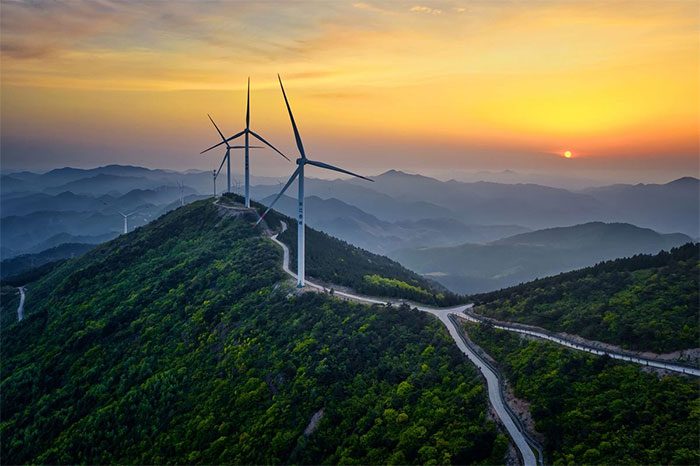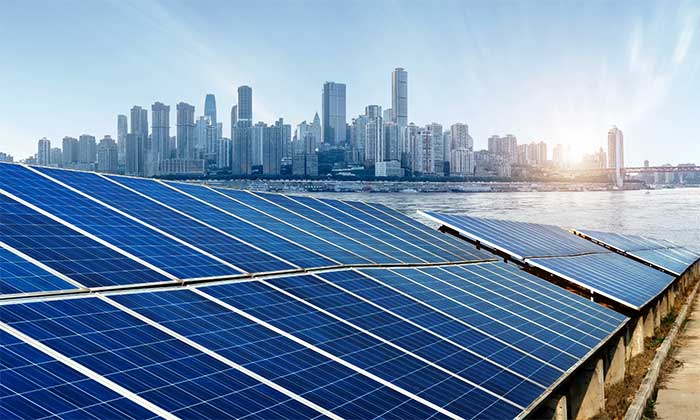Many people may remember that Beijing was once considered one of the most polluted cities in the world. The image of China’s capital shrouded in thick smog and a murky atmosphere has haunted many who have witnessed it.

Image of Beijing’s capital city shrouded in haunting smog.
However, China is now entering a new era of clean air. According to the air quality measurement application IQAir, no city in China is among the top 5 areas with polluted air.
Beijing, once the most polluted city in the world about a decade ago, now ranks between 30th and 40th in IQAir’s real-time rankings.
The improvement in air quality in Beijing specifically, and major cities in China generally, demonstrates that the country’s anti-pollution campaign has achieved significant milestones.
Now, China even shows that it is leading in greenhouse gas transformation, clean energy, and reducing dependence on fossil fuel sources.
Strict Control of Emission Sources

Cooling tower and smokestacks at a thermal power plant in Beijing, China. (Photo: Reuters).
Cities in China have long struggled with high levels of air pollution due to overpopulation, coupled with a surge in carbon emissions from daily activities and various emission projects.
To improve air quality, Chinese officials understand that they must address the sources of emissions at their root.
As such, they have proposed a series of new measures and policies aimed at strictly and reasonably controlling the total amount of coal used and limiting high-emission projects to enhance air quality.
Other proposed measures include: developing new and clean energy sources, increasing natural gas production, and limiting projects that lead to high energy consumption and emissions.
The plan aims to reduce coal consumption in the Beijing-Tianjin-Hebei region and surrounding areas by about 10% compared to 2020 levels by 2025, with a goal of a 5% reduction for the Yangtze River Delta region.
Alongside this, coal usage in Shanxi and Shaanxi provinces in northern China is also being cut during the same timeframe. Officials are also accelerating the elimination of high-polluting and outdated industries.
According to the plan, by 2025, China aims to reduce the concentration of hazardous particles in the air, known as PM2.5, by 10% compared to 2020 and keep the number of severely polluted days below 1%.
For traffic emissions control, Beijing is limiting the number of vehicles. Concurrently, they are establishing green transport systems and encouraging citizens to use electric vehicles to reduce carbon emissions.
To support this transition, fast-charging stations are expected to be available in at least 80% of highway areas and key regions including Beijing, Tianjin, Shanghai… and no less than 60% in other areas by 2025.
Carbon Dioxide Conversion Systems

Carbon dioxide conversion systems make the atmosphere cleaner.
In addition to reducing emission sources, China’s carbon dioxide conversion systems are seen as a milestone in greenhouse gas mitigation, which helps make the atmosphere cleaner.
Essentially, these systems function as “giant air purifiers”, helping to reduce the amount of pollutants and transform them into usable substances.
In early 2024, researchers at Huazhong University of Science and Technology (HUST) in Wuhan introduced a Electrolysis System that can convert carbon into formic acid with an efficiency of over 93%.
This process involves breaking the chemical bonds of carbon dioxide and then adding hydrogen to create various valuable hydrocarbons, such as formic acid, methanol, ethanol, alkanes, or olefins.
Formic acid—the end product of the conversion system—has many applications in chemicals, energy, agriculture, and other fields.
The primary application of this compound is as a preservative and antimicrobial agent in animal feed. It can also be used in fuel cells, leather production, and toilet cleaning products…
Importantly, the system can operate continuously for at least 5,000 hours, longer than any other devices currently being researched.
An additional benefit is that the electrolyte used in this new process can be sourced directly from used lead-acid batteries, providing a greener and more sustainable option.
Wind and Solar Energy – New Energy Sources

Wind turbine array on a mountain range in China. (Photo: Getty).
Merely limiting emissions and combating pollution is not enough. To aim for a long-term future where humanity utilizes new and environmentally friendly energy sources, China has heavily invested in solar and wind energy.
With the advantage of its vast territory and long coastline, China currently leads the world by accounting for 56% of the installed capacity of wind energy systems, a significant increase from the 37% recorded in 2018.
By 2022, China’s cumulative offshore wind power capacity reached about 31 gigawatts, surpassing Europe for the first time to claim the top global position.
New installed capacity in China in the same year was around 5 gigawatts, which is double that of Europe.
In mid-2023, China successfully launched the MySE 16-260 wind turbine, the largest in the world, installed at an offshore wind farm near Fujian Province.
This giant turbine stands 152 meters tall, weighs 54 tons, with each blade measuring 123 meters. Once operational, the turbine’s blades cover an area of nearly 50,000 square meters, generating a capacity of 16 megawatts.
It is worth mentioning that this is the first time such a large turbine has been connected to the commercial power grid.

Wind and solar power in China are expected to surpass coal energy by 2024. (Photo: Getty).
Along with wind energy, solar energy is also being maximally harnessed by China. In 2023, the country added more solar panels than any other nation.
This figure reached 216.9 gigawatts of solar energy in 2023, breaking the previous record of 87.4 gigawatts set in 2022, according to a report from the National Energy Administration. Meanwhile, the United States—the second-largest solar energy market in the world—only achieved 175.2 gigawatts, according to BloombergNEF estimates.
The China Electricity Council (CEC) in its annual report stated that wind and solar energy will account for about 40% of electricity generation capacity by the end of 2024, while coal energy will decrease to 37%.
CEC expects China to build approximately 1,300 gigawatts (GW) of wind and solar capacity by the end of 2024, meaning the country will exceed the official target of 1,200 GW set for 2030.
With a series of comprehensive measures focusing on improving air quality and transitioning to environmentally friendly energy sources, China has truly made significant progress.
Importantly, China’s success in this field could serve as a significant boost for developing economies around the world, creating a race where humanity can benefit.


















































